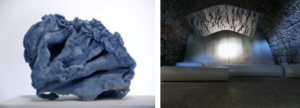A new generation of artists committed to the environment is emerging in France.
Our editorial team proposes to explore four major trends within this young committed scene, from the 21 winners of the Planète Art Solidaire support awarded by Art of Change 21 (editor of this blog), sponsored by Maison Ruinart.
See also other trends:
The New Druids
The Anthropologists of the Common Good
The Anthropocene Composters
Like scientists, young artists probe the extremes of the scales of time and space, with an environmental awareness and sense of belonging to the living encouraging more intimate and symbolic relationships. Geology, biology, physics, scientific knowledge and tools are used in a new, less anthropocene narrative that challenges the place of humans and empowers the artist in the face of the climate crisis. Like the first natural scientists and climatologists, artists become travelers and explorers, from the North Pole to irradiated lands or the marine world. Nature also offers them analog figures to question humankind’s place… like that of the parasite.
Hugo Deverchère looks to the cosmos, the Earth and the various geological dimensions of its landscapes – geological, chemical, biological, and even symbolic. His installations mix the organic, vegetable and mineral in living and evolving protocols and mechanisms, inviting the viewer to observe these little known phenomena and reconsider their relationship with the environment beyond an anthropocentric perspective. His latest exploratory work La Isla de las Siete Ciudades (The Isle of the Seven Cities) looked at legendary islands through their geological, biological and mythological legacy.
Artist Julie Escoffier joined forces with Héloïse Thouement, a chemical/environmental engineer specializing in polluted sites and soils, to form the duo Evernia. Their work is both artistic and scientific, focusing on the “parasitical” relationship humans have with nature, in which they act as the parasite that both preserves and changes their host. Recently, as part of a residency at the CIAP in Vassivière-en-Limousin, they created Le Goût de la forêt (The taste of the forest), a recipe using lichen. They are also working together on Héloïse Thouement’s applied research project, “PHYTOCARB”, which uses trees as pollution traps. .
The Corail Artefact project by artist Jérémy Gobé is based on an ancient stitch used in lace-making, an industrial activity in decline, and coral, now threatened by global warming and pollution. In 2019, the artist showed how lace made from organic cotton could be used as a potential structure to promote coral growth. A series of new tests will be carried out when possible.
Sara Favriau is currently working on a long-term forestation project alongside the Mediterranean Forest Conservation research body of INRAE Avignon. She delves into not only the land itself, but also the climate, environmental and socioeconomic issues and vulnerabilities threatening our forests. This project combining art and science delivers its findings in a poetic and sensitive manner: sculpture, performance, theatre, film, a tree-pirogue going out to sea…

Marie-Luce Nadal, artist and interdisciplinary researcher, who has a SACRe Doctorate (Sciences, Arts, Creation and Research), creates performative mechanical works of art in response to the climate and meteorological phenomena that fascinate her. These new modes of representation, sensitive to the world around us, answer a key question: how do we live fairly in our world without destroying the life and diversity that are so essential to our survival? Her project S.O.S (The Skin Of the Sky) supported by the Jet Propulsion Laboratory (NASA) attempts to find a protective armour for the planet, based on the study of lightning and thunderstorms, which have now become increasingly common.
Alice Audouin and Pauline Lisowski
June 2021
Photo credits:
Jérémy Gobé, Corail Artefact-sculpture 6, squelette de coraux dentelle en coton, enduit durcissant écologique, peinture à l’eau sans solvant, ©Thomas Granovsky, courtesy of the artist / Marie-Luce Nadal, Menace et Tremblements, sculpture activable exposée lors de l’exposition collective « Regarder l’agreste paysage », Afiac, 2018 / Hugo Deverchère, La isla de las siete ciudades, exposition à la Galerie Sator Komunuma, Romainville, France, 2021 / Julie Escoffier et Héloïse Thouement, Par l’ombre sensible, l’écriture d’une image, série d’œuvres plastiques sur verre, réalisées avec des pigments réalisés à partir d’éléments issus de la ligniculture
Find all the articles from Impact Art News n°31 – June 2021
To subscribe to Impact Art News (free) : here

